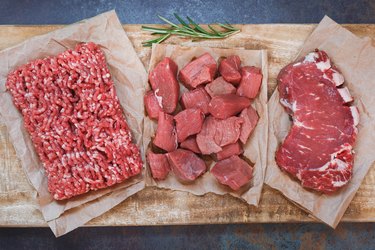
Eating rare steak is safer and more common than eating undercooked chicken, but this doesn't mean it's safe. Depending on its type and how it's stored, undercooked meat may cause unpleasant and harmful side effects.
Is Eating Rare Steak Safe?
Video of the Day
Many times, people don't like eating their steak medium well or well done because it becomes dry and loses its flavor. According to the Academy of Nutrition and Dietetics, there is no way to guarantee the safety of rare meat. The best way to ensure that medium-rare steak, roasts or chops are safe for consumption is to cook them until their internal temperature reaches at least 145 degrees Fahrenheit.
Video of the Day
If you use ground beef, pork or lamb, you cannot prepare them medium-rare. That's because the process of grinding can allow harmful bacteria to enter the food. Ground meat needs to reach 160 degrees Fahrenheit internally, while ground chicken or turkey should reach a minimum internal temperature of 165 degrees Fahrenheit.
As the Cleveland Clinic notes, it's impossible to tell if your meat is done just by looking at it. The only foolproof way to check whether or not the meat is cooked through is to use a food thermometer.
Read more: How to Cook a Tender Steak on the Stove
Beware of Food Poisoning Symptoms
Food poisoning results from eating contaminated food, points out the Mayo Clinic. The most common causes include food contaminated with infectious bacteria, viruses and parasites or the toxins they produce.
These pathogens can contaminate food at any point during processing or production, including at home, if the food is not properly prepared. Food poisoning can occur within hours of eating the contaminated food and may cause the following symptoms:
- Nausea
- Vomiting
- Watery or bloody diarrhea
- Abdominal pain and cramps
- Fever
Raw meat (and sometimes even medium-rare steak) is not considered safe for people who are at a higher risk of food poisoning. The Centers for Disease and Control Prevention states that anybody can get food poisoning, but certain groups are more prone to it because their bodies' ability to fight germs and sickness is limited. These populations include adults aged 65 and older, children younger than five, pregnant women and people with weakened immune systems due to illness.
Good Food Safety Practices
Government inspectors often oversee meat and poultry processing to ensure they are following federal regulations. However, consumers must follow food safety practices when storing and cooking meat to avoid potential side effects, such as food poisoning.
The United States Department of Agriculture suggests the following:
- Wash hands and surfaces before and after handling raw meat.
- Keep meat away from other foods to avoid cross-contamination.
- Refrigerate meats at 40 degrees Fahrenheit or below.
- Never pick out meat or poultry with packaging that has tears or leaks.
- Do not buy or use meats that have passed their "Sell by" or "Use by" dates.
- Refrigerate meats within two hours of buying, or one hour if the temperature is 90 degrees Fahrenheit or above.
- Cook or freeze fresh poultry within two days, and beef, veal, lamb or pork meat within three to five days.
- Discard any food left out at room temperature for longer than two hours.
- Academy of Nutrition and Dietetics: "Can Rare Meat Be Safe?"
- Cleveland Clinic: "Are Your Burgers, Steaks and Meats Cooked Safely?"
- Centers for Disease and Control Prevention: "People With a Higher Risk of Food Poisoning"
- Mayo Clinic: "Food Poisoning"
- United States Department of Agriculture: "Basics for Handling Food Safely"
Was this article helpful?
150 Characters Max
0/150
Thank you for sharing!
Thank you for your feedback!